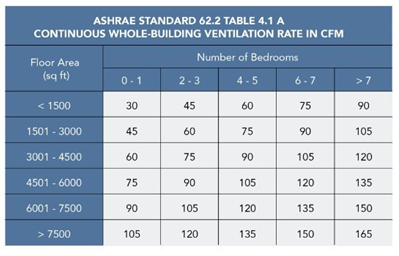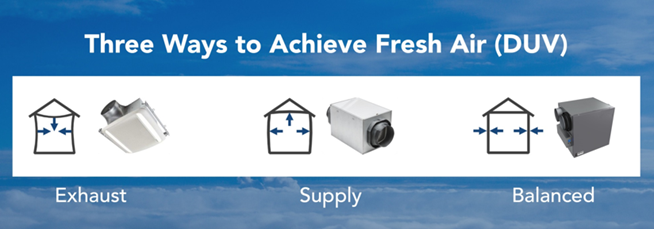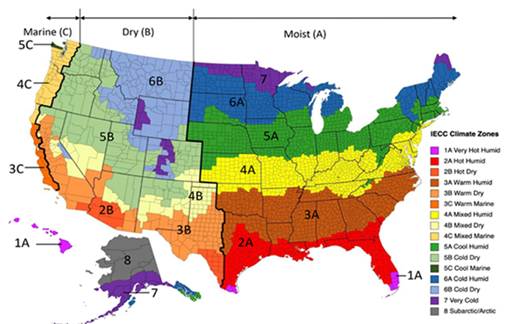How Indoor Air Quality is Shaping the Future
Today, builders hold a crucial role in meeting energy codes, earning tax credits, and providing a comfortable home filled with fresh, clean air. So, we want to help you understand the importance of using whole dwelling ventilation to optimize Indoor Air Quality for your current and future projects and how you can lower your HERS score while doing so.Ventilation 101
Ventilating a home involves exchanging indoor and outdoor air to maintain good indoor air quality. And there are three types of ventilation: exhaust, supply, and balanced in which Broan-NuTone can help you with the selection criteria of the proper ventilation to maximize airflow and energy efficiency.
Navigating the Complexities of Modern Homes
Navigating and implementing energy codes and advanced building methods can be a bit tricky. But with our expertise and partnership, we can help guide you and break it down for you.Why Ventilation Matters
Proper ventilation ensures the effective removal of indoor pollutants, regulates air quality, contributes to the overall comfort of occupants in a home, and is often required by building and energy codes.
- Code Compliance- Adhering to these regulations is crucial in design and construction.
- Energy Efficiency – contribute to sustainable and cost-effective solutions which will improve energy modeling scores and save homeowners money.
- Moisture Control- avoid potential problems associated with excessive or insufficient moisture.
- System Optimization- use ventilation systems that work seamlessly.
- Health and Comfort – occupants can breathe clean and fresh air, reducing the risk of respiratory issues and improving comfort in the home.
The Result of the Tightening Envelope
More airtight homes lead to varied indoor climates, leaving some spaces slightly uncomfortable and increasing risks of mold and mildew buildup. The risks of depressurized dwellings, back-drafting, and the inflow of poor air pose complex challenges that require an engineering-based approach. As featured in the graphic, homes averaged over twelve (12) air changes per hour at 50 pascals of pressure difference in 1975. Today, it is averaging less than five (5).

Trapped Indoor Pollutants
Excess moisture, particulates, gasses/VOCs, carbon dioxide, and odors trapped in the home pose significant challenges. Tighter homes with new improved sealing technologies effectively seal these pollutants in the home now more than ever.
Code Requirements
Where the model building codes require dwelling unit ventilation, the airflow requirements are based on the rates from ASHRAE 62.2-2010 which are based on the square footage of the dwelling and number of bedrooms. The International Energy Conservation Code (IECC) continues to become more stringent with each revised version including requirements for HRVs/ERVs in more applications.
Three Ways to Achieve Fresh Air (DUV)

The three primary ways we can achieve proper ventilation are exhaust ventilation, supply ventilation, and balanced ventilation. Each method offers its own set of advantages.
 Exhaust Ventilation:
Exhaust Ventilation:Exhaust ventilation fans pull stale air out of the home and thus depressurizes the home.This method relies on natural leakage in the envelope to provide a source of new air. It has the advantage of low first cost and the lowest maintenance. The new Broan EVOLVE premium bath fan series is an ideal solution to meet DUV requirements if choosing an exhaust-only strategy. It features adjustable, continuous run capability, nearly silent operation, ECM motors for energy efficiency, guaranteed performance as well as fast, easy installation.
 Supply Ventilation:
Supply Ventilation:Supply ventilation brings fresh air directly to the home via a fan. The idea here is to push fresh air into the home, thus pressurizing the home and forcing the stale/bad air out of the nooks and crannies left in the building envelope.
There are two basic supply methods:
- Central Fan Integrated Supply (CFIS)– This method uses a supply damper and a fresh air duct from outside that is directed into the return air plenum. It relies on the central fan to draw fresh air into the home. Our Broan FIN-6MD is a supply damper that measures the outdoor temperature and humidity to determine the best time to bring fresh air into the home.
- Dedicated Supply Fans – Supply fans are more energy efficient than a CFIS because they do not rely on a large central fan to do a smaller job. These fans make it easier to control airflow, as well since they have their own airflow control within the unit. It can be challenging to measure and set the correct airflow with central fan integrated systems. The Broan FIN-180P supply fan also features temperature and humidity controls to optimize when it is most efficient to ventilate.
 Balanced Dwelling Unit Ventilation:
Balanced Dwelling Unit Ventilation:Balanced systems combine simultaneous mechanical exhaust and mechanical supply and thus do not rely on holes in the building envelope for airflow. When both fans are contained within the same unit, they are sometimes called air exchangers. Today’s tighter homes make this an ideal solution.
The most effective of these types of ventilation systems are called Energy Recovery Ventilators (ERVs), which efficiently manage temperature and humidity or Heat Recovery Ventilators (HRVs) which are designed to efficiently manage only temperature. Inside an ERV is a core. In that core both the incoming and outgoing air streams pass by each other but never mix, transferring both heat and moisture. In the winter, cold, dry air passes by warm, humidified air and the heat and humidity from inside the home pass to the incoming cold dry air, warming and humidifying it. In the summer, this core will absorb the incoming warm, humid air and give it up to the exhausted airstream.
The key for builders is being able to promise homeowners significant dollar savings on their energy bills and more importantly allowing them to realize relatively inexpensive HERS point savings or improve performance compliance path modeling for the energy code.
The Path to the Future
Broan-NuTone’s DUV systems can be extremely attractive relative to a builder’s alternative energy efficiency options on an installed cost per HERS point basis.
- The cost per HERS point in terms of efficiency upgrade options can vary by climate zone. As northern climates have a greater temperature difference from inside-to-outside for much of the year, upgrades such as improved insulation or windows and ERVs typically save more HERS points there. A more efficient bath fan (cfm/watt) on the other hand does not vary as the same wattage savings are realized no matter the climate zone.
- HERS points become more challenging the lower you get on the scale.
- The installed cost of different energy efficiency options can vary significantly from region-to-region or builder-to-builder due to hourly labor costs, regional material pricing differences or simply how common a certain product is in a specific market.

While it is difficult to determine a national average installed cost per HERS point savings, in most regions these savings are likely worth many hundreds of dollars per point. One can easily see why builders are increasingly deciding to specify Broan premium ventilation products to help them realize their 45L tax credit.
Broan-NuTone works with reputable energy modeling and rating firms across North America to evaluate the benefits of ventilation strategies to meet your application needs and achieve the HERS SCORE target. Let’s partner to develop a path toward creating healthier and more comfortable living spaces with ventilation strategies to meet your application needs and achieve your HERS score target. Learn more HERE.

 English
English
 English
English